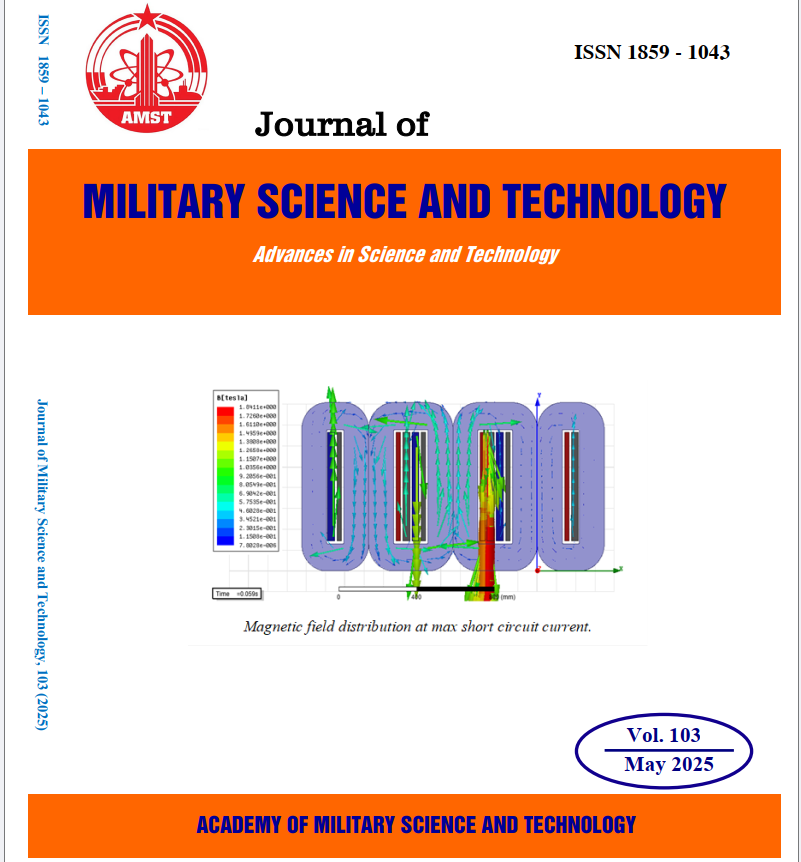Bearing fault diagnosis by machine learning and deep learning-based models: A comparative study applying for HUST bearing dataset
531 viewsDOI:
https://doi.org/10.54939/1859-1043.j.mst.103.2025.31-39Keywords:
Bearing fault diagnosis; Machine learning; Deep learning; Convolutional neural network; Long short-term memory; Support vector machine; Transformer model.Abstract
Diagnosing bearing faults is essential for ensuring the reliability and operational safety of mechanical and electronic systems. This paper presents a comparative analysis of different machine learning-based models for classifying bearing fault conditions, including Support Vector Machines (SVM), Long Short-Term Memory (LSTM) networks, One-Dimensional Convolutional Neural Networks (1D-CNN), Two-Dimensional Convolutional Neural Networks (2D-CNN), and Transformer model. These models are applied to the HUST bearing dataset and evaluated based on their ability to accurately classify defects from vibration signal data. The results indicate that 1D-CNN, 2D-CNN, and Transformer model exhibit superior performance in bearing fault diagnosis. 1D-CNN attained 99.8% accuracy on the training set and 99.83% on the test set, followed by 2D-CNN with 99.1% and 99.3%, respectively. The Transformer model also performed well, reaching 99.7% accuracy within 1 hour of training, similar to 1D-CNN (1 hour) and 2D-CNN (0.8 hours). In contrast, LSTM and SVM exhibited lower accuracy and significantly longer training times, with LSTM requiring 11.5 hours and SVM 8 hours. These findings suggest that 1D-CNN, 2D-CNN, and the Transformer model are highly effective approaches for bearing fault diagnosis, with the Transformer model achieving performance and training efficiency comparable to CNN-based models.
References
[1]. Wang Y., Li D., Li L., et al. "A novel deep learning framework for rolling bearing fault diagnosis enhancement using VAE-augmented CNN model". Heliyon, 10(15), e35407, (2024). DOI: https://doi.org/10.1016/j.heliyon.2024.e35407
[2]. Hakim M., Omran A.A.B., Ahmed A.N., et al. "A systematic review of rolling bearing fault diagnoses based on deep learning and transfer learning: Taxonomy, overview, application, open challenges, weaknesses and recommendations". Ain Shams Eng J, 14(4), 101945, (2023).
[3]. Tian A., Zhang Y., Ma C., et al. "Noise-robust machinery fault diagnosis based on self-attention mechanism in wavelet domain". Measurement, 207, 112327, (2023). DOI: https://doi.org/10.1016/j.measurement.2022.112327
[4]. Vyas N.S. and Satishkumar D., "Artificial neural network design for fault identification in a rotor-bearing system". Mech Mach Theory, 36(2), 157–175, (2001). DOI: https://doi.org/10.1016/S0094-114X(00)00034-3
[5]. Dong S., Xu X., Liu J., et al. "Rotating machine fault diagnosis based on locality preserving projection and back propagation neural network–support vector machine model". Meas Control, 48(7), 211–216, (2015). DOI: https://doi.org/10.1177/0020294015595995
[6]. Hakim M., Omran A.A.B., Ahmed A.N., et al. "A systematic review of rolling bearing fault diagnoses based on deep learning and transfer learning: Taxonomy, overview, application, open challenges, weaknesses and recommendations". Ain Shams Eng J, 14(4), 101945, (2023). DOI: https://doi.org/10.1016/j.asej.2022.101945
[7]. Han S. and Jeong J., "An weighted CNN ensemble model with small amount of data for bearing fault diagnosis". Procedia Comput Sci, 175, 88–95, (2020). DOI: https://doi.org/10.1016/j.procs.2020.07.015
[8]. Jiang H., Li X., Shao H., et al. "Intelligent fault diagnosis of rolling bearings using an improved deep recurrent neural network". Meas Sci Technol, 29(6), 065107, (2018). DOI: https://doi.org/10.1088/1361-6501/aab945
[9]. R. Sabir, D. Rosato, S. Hartmann and C. Guehmann. "LSTM based bearing fault diagnosis of electrical machines using motor current signal", 18th IEEE International Conference On Machine Learning And Applications (ICMLA), Boca Raton, FL, USA, pp. 613-618, (2019), doi: 10.1109/ICMLA.2019.00113. DOI: https://doi.org/10.1109/ICMLA.2019.00113
[10]. H. Wu, M. J. Triebe, J. W. Sutherland. "A transformer-based approach for novel fault detection and fault classification/diagnosis in manufacturing: A rotary system application". Journal of Manufacturing Systems, 67, 439-452, (2023). DOI: https://doi.org/10.1016/j.jmsy.2023.02.018
[11]. Thuan N.D. and Hong H.S. "HUST bearing: a practical dataset for ball bearing fault diagnosis". BMC Res Notes, 16(1), 138, (2023). DOI: https://doi.org/10.1186/s13104-023-06400-4
[12]. Cortes C. and Vapnik V. "Support-vector networks". Mach Learn, 20(3), 273–297, (1995). DOI: https://doi.org/10.1007/BF00994018
[13]. Kankar P.K., Sharma S.C., and Harsha S.P. "Fault diagnosis of ball bearings using machine learning methods". Expert Syst Appl, 38(3), 1876–1886, (2011). DOI: https://doi.org/10.1016/j.eswa.2010.07.119
[14]. LeCun Y., Bengio Y., and Hinton G. "Deep learning". Nature, 521(7553), 436–444, (2015). DOI: https://doi.org/10.1038/nature14539
[15]. Yang J., Chen F., Long A., et al. "Runoff simulation of the Kaidu River Basin based on the GR4J-6 and GR4J-6-LSTM models". J Hydrol Reg Stud, 56, 102034, (2024). DOI: https://doi.org/10.1016/j.ejrh.2024.102034
[16]. A. Vaswani, N. Shazeer, N. Parmar., et al. "Attention is all you need. NIPS'17": Proceedings of the 31st International Conference on Neural Information Processing Systems, 6000-6010, (2017).







